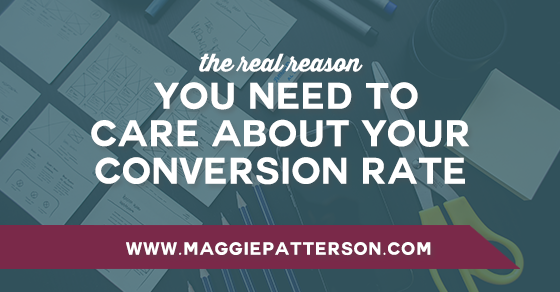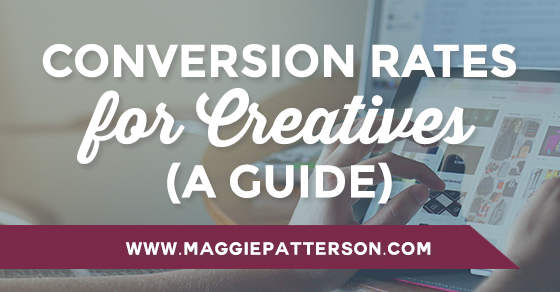
If you build it, they will come. (Insert other tired clichés here.)
When it comes to the web, that’s sooooo not the case. For some reason, even in 2015, we’re conditioned to think that you launch your site and ta-da! The world will be SO excited and you’ll be drowning in traffic.
Nothing could be further from the truth. To have traffic (aka visitors) to your site, you’re going to need to hustle. From blogging to social media to guest posting to whatever else you decide to do, you’ll need to put time in to getting them to your little slice of Internet.
And once you’ve done the hard work of getting them to your site, the even harder part starts…keeping them there.
Unfortunately, this is where so many websites (especially in our online entrepreneurial world) fail. Epically. Massively. Disastrously.
There’s countless reasons this happens, but the bottom line is that if you have visitors coming to your site and you’re not converting them, all of your efforts are a bloody waste.
If that seems dramatic, hold on to your hat – because it comes down to simple math:
Let’s say you get 100 visitors to your site, but only 2 convert into a sale, which gives you a 2% conversion. If you want to make more sales and more money, do you try to double the number of visitors to your site?
Or do you improve your site so you can get 6 or 10 of the visitors to buy from you? By improving your conversions, you’ll get 3x or 5x the sales from people already visiting your site.
So in classic sales speak, do you serve the people you already have or do you work to acquire more leads?
As someone who literally built the foundation of my business on referrals, I know exactly what I’m going to do in this situation. I’d focus on ensuring that the people already coming to me are getting what they need to improve my conversion rate, instead of hustling and grinding to get more and more and more traffic.
The answer isn’t more traffic, it’s more conversions on your site. If you want to reach your business goals, you need to give a flying fig about this conversion rate stuff. (Even if you’re a creative and math makes you all stabby, because this is the stuff that impacts your bottom line and very likely your sanity.)
So, why, then, are so many sites failing when it comes to creating the connection with visitors and closing the sale?
[Tweet “Your website doesn’t have a traffic problem. It has a conversions problem, says @magspatterson #conversionschallenge”]
Here are just a few of the reasons it happens:
#1. Pretty Over Practical
Have you ever arrived on a stunning website and thought, “Okay, this is so cool. Wait, WTF am I supposed to do now?” Me too, and way more often than I care to admit.
While we can all make fun of the web 1.0 sites out there from the Internet marketing dudes that are red, black and yellow, I’ll tell you one thing, those sites often convert like gangbusters. They work because they are extremely well thought out and use proven principles to move people into action.
Does this mean you need an ugly site from 1999 to convert visitors? No. Hell no. But it does mean you need to get much more intentional about what you want your visitors to actually do when they land on your home page. You need a plan that takes them from home to the place where you want them: a place where they feel comfortable enough to opt-in, buy, or get in touch.What’s the plan that gets them from home to the ultimate place where you want them to opt-in, buy or take action?
It’s way too easy to be caught up in the cool design, groundbreaking images or funky navigation. But if your visitors don’t get it, it doesn’t matter.
When you’re assessing designers, you want to look for someone who speaks the language of conversion and digital strategy. Pretty is great, but if your site isn’t doing its job, it’s not going to give you the ROI you need. In a world where User Experience (UX) and User Interface (UI) are critical (thanks, Apple), you can’t afford not to have a clear plan for how people interact with your site.
#2 Copy That’s Clever, But Not Clear
Way back in the day, when I was studying writing for the web, we had a catchy way of assessing our writing, and we were marked against this filter. Meet the 4Cs: – clear, correct, complete and concise.
If your copy can’t pass that test, you may have a conversion problem.
Clever, cute, quippy, whatever you want your copy to be, you can’t sacrifice clarity. Because without clarity, no one – and I mean no one – is going to be able to decipher what you’re really saying. And that means they’re they are not going to stick around to sign up for your list or read more about your products or services.
Truth is, as attached as you may be to your words, cut that by about 95%, because that’s about how much your reader really cares. Yes, you need to connect with them and address their problem, but they also want you to do it in a way that doesn’t make them feel like they’re a Ph.D. candidate or that they need a dictionary to understand.
If you want your copy to convert, you need to answer your customer’s most burning the question: “What’s in it for me?” and then make sure that you’re speaking your reader’s language. And if you really want to have copy that gets results, please don’t confuse conversion-boosting copy with the breed of personality-driven, fluffy copy that’s all style and no substance.
#3 You’re Making it Too Damn Hard
Nothing, and I mean nothing, kills conversions like making it too damn hard for a visitor to do business with you.
If you really want people to convert, you need to make things dead easy for them to follow through. From clear pricing to answering questions upfront to having calls to action that make sense, your job is to reduce the number of decisions they need to make.
It’s called Decision Paradox. And if you’ve ever been to the Cheesecake Factory, you know exactly what that’s all about. When we have too many decisions, we tend to over analyze things. So the fewer decisions you can offer up for your visitors, the better.
A great example of where many online businesses make it too hard is with pricing. If you make it hard for your visitor to figure out what something costs and how to do business with you, you’ve just created friction. With every second they spend doing math or figuring out what happens if they do press buy, you’re giving them time to reconsider.
Same thing with your call to action buttons. You need to make it so crazy simple that they can take action on autopilot and feel like they’re making the right choice. Asking for too much info, making them click one too many times, or being unclear means more decisions. And with every decision, they become more apt to abort their mission.
Life is hard enough, so if you make it hard for visitors to get the information, purchase or subscribe, you’re not building trust, and you’re less likely to convert them into action.
Think about your favorite stores or brands. I’m willing to bet they’re the ones that make things simple. Their merchandising, their pricing and the overall experience is relaxing and makes it easy for you to give them your money.
Your website should do the exact same thing. Less is more, especially if you’re talking conversions.
[Tweet “Are you making it HARD to do business with you? @magspatterson breaks down common problems”]


